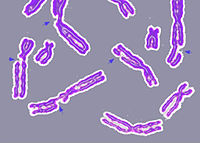
Non‐homologous end joining: Common interaction sites and exchange of multiple factors in the DNA repair process
Sign Up to like & getrecommendations! Published in 2017 at "BioEssays"
DOI: 10.1002/bies.201600209
Abstract: Non‐homologous end‐joining (NHEJ) is the dominant means of repairing chromosomal DNA double strand breaks (DSBs), and is essential in human cells. Fifteen or more proteins can be involved in the detection, signalling, synapsis, end‐processing and… read more here.
Keywords: end joining; end; homologous end; interaction ... See more keywords

Genistein‐induced DNA damage is repaired by nonhomologous end joining and homologous recombination in TK6 cells
Sign Up to like & getrecommendations! Published in 2019 at "Journal of Cellular Physiology"
DOI: 10.1002/jcp.27082
Abstract: Genistein (GES), a phytoestrogen, has potential chemopreventive and chemotherapeutic effects on cancer. The anticancer mechanism of GES may be related with topoisomerase II associated DNA double‐strand breaks (DSBs). However, the precise molecular mechanism remains elusive.… read more here.
Keywords: end joining; dna damage; tk6; induced dna ... See more keywords

CRISPR-Cas9-assisted native end-joining editing offers a simple strategy for efficient genetic engineering in Escherichia coli
Sign Up to like & getrecommendations! Published in 2019 at "Applied Microbiology and Biotechnology"
DOI: 10.1007/s00253-019-10104-w
Abstract: Unlike eukaryotes, prokaryotes are less proficient in homologous recombination (HR) and non-homologous end-joining (NHEJ). All existing genomic editing methods for Escherichia coli (E. coli) rely on exogenous HR or NHEJ systems to repair DNA double-strand… read more here.
Keywords: end joining; end; native end; genetic engineering ... See more keywords

A curious new role for MRN in Schizosaccharomyces pombe non-homologous end-joining
Sign Up to like & getrecommendations! Published in 2017 at "Current Genetics"
DOI: 10.1007/s00294-017-0760-1
Abstract: Chromosomal breaks can be healed by several repair processes, including one called non-homologous end-joining (NHEJ) where the two broken ends are ligated together with a loss of 0–5 bp of DNA. The protein requirements for NHEJ… read more here.
Keywords: end joining; schizosaccharomyces pombe; homologous end; mrn ... See more keywords

Pol I DNA polymerases stimulate DNA end-joining by Escherichia coli DNA ligase.
Sign Up to like & getrecommendations! Published in 2018 at "Biochemical and biophysical research communications"
DOI: 10.1016/j.bbrc.2018.01.165
Abstract: Klenow and Klentaq are the large fragment domains of the Pol I DNA polymerases from Escherichia coli and Thermus aquaticus, respectively. Herein, we show that both polymerases can significantly stimulate complementary intermolecular end-joining ligations by… read more here.
Keywords: end joining; dna; coli dna; dna ligase ... See more keywords

Deletion of yeast TPK1 reduces the efficiency of non-homologous end joining DNA repair.
Sign Up to like & getrecommendations! Published in 2020 at "Biochemical and biophysical research communications"
DOI: 10.1016/j.bbrc.2020.09.083
Abstract: Non-homologous end joining (NHEJ) is a highly conserved mechanism of DNA double-stranded break (DSB) repair. Here we utilize a computational protein-protein interaction method to identify human PRKACB as a potential candidate interacting with NHEJ proteins.… read more here.
Keywords: end joining; deletion; homologous end; tpk1 ... See more keywords

Control of DNA end resection by yeast Hmo1p affects efficiency of DNA end-joining.
Sign Up to like & getrecommendations! Published in 2017 at "DNA repair"
DOI: 10.1016/j.dnarep.2017.03.002
Abstract: The primary pathways for DNA double strand break (DSB) repair are homologous recombination (HR) and non-homologous end-joining (NHEJ). The choice between HR and NHEJ is influenced by the extent of DNA end resection, as extensive… read more here.
Keywords: end joining; end resection; end; dna end ... See more keywords

Inhibition of non-homologous end joining in Fanconi Anemia cells results in rescue of survival after interstrand crosslinks but sensitization to replication associated double-strand breaks.
Sign Up to like & getrecommendations! Published in 2018 at "DNA repair"
DOI: 10.1016/j.dnarep.2018.02.003
Abstract: When Fanconi Anemia (FA) proteins were depleted in human U2OS cells with integrated DNA repair reporters, we observed decreases in homologous recombination (HR), decreases in mutagenic non-homologous end joining (m-NHEJ) and increases in canonical NHEJ,… read more here.
Keywords: end joining; fanconi anemia; homologous end; replication associated ... See more keywords

MRI Is a DNA Damage Response Adaptor during Classical Non-homologous End Joining.
Sign Up to like & getrecommendations! Published in 2018 at "Molecular cell"
DOI: 10.1016/j.molcel.2018.06.018
Abstract: The modulator of retrovirus infection (MRI or CYREN) is a 30-kDa protein with a conserved N-terminal Ku-binding motif (KBM) and a C-terminal XLF-like motif (XLM). We show that MRI is intrinsically disordered and interacts with… read more here.
Keywords: end joining; dna damage; damage response; classical non ... See more keywords
Homology-mediated end joining-based targeted integration using CRISPR/Cas9
Sign Up to like & getrecommendations! Published in 2017 at "Cell Research"
DOI: 10.1038/cr.2017.76
Abstract: Targeted integration of transgenes can be achieved by strategies based on homologous recombination (HR), microhomology-mediated end joining (MMEJ) or non-homologous end joining (NHEJ). The more generally used HR is inefficient for achieving gene integration in… read more here.
Keywords: end joining; mediated end; integration; homology ... See more keywords

Molecular basis of microhomology-mediated end-joining by purified full-length Polθ
Sign Up to like & getrecommendations! Published in 2019 at "Nature Communications"
DOI: 10.1038/s41467-019-12272-9
Abstract: DNA polymerase θ (Polθ) is a unique polymerase-helicase fusion protein that promotes microhomology-mediated end-joining (MMEJ) of DNA double-strand breaks (DSBs). How full-length human Polθ performs MMEJ at the molecular level remains unknown. Using a biochemical… read more here.
Keywords: end joining; polymerase helicase; pol; dna ... See more keywords